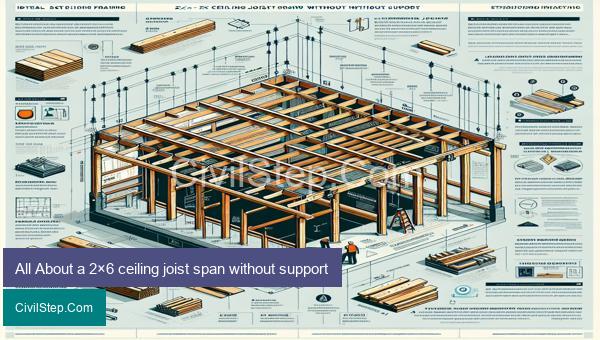
Ceiling joists are an essential component of any building’s construction, providing support and stability to the structure. Among the various types of joists, the 2×6 ceiling joist is a popular choice due to its affordability and easy availability. However, a major concern for builders and homeowners is the span of a 2×6 ceiling joist without support. In this article, we’ll explore all the crucial details about the span of a 2×6 ceiling joist without support, including its limitations, benefits, and necessary precautions to ensure a safe and sturdy construction. Whether you’re a homeowner planning a renovation or a builder looking for the right joist for your project, this article will provide you with all the information you need
How far can a 2×6 ceiling joist span without support

Ceiling joists are an essential structural element in a building’s construction. They support the weight of the ceiling and any other loads above it. The span of a ceiling joist, which is the distance it can cover without any additional support, is an important factor to consider during the design and construction of a building. In this article, we will discuss how far can a 2×6 ceiling joist span without support.
First, let’s understand what a 2×6 ceiling joist is. It is a type of dimensional lumber that measures 1.5 inches thick and 5.5 inches wide. These joists are commonly used in residential construction, particularly in small or medium-sized rooms. They are typically made from softwood such as pine or fir, which is strong and widely available.
There are several factors that affect the span of a 2×6 ceiling joist without support. These include the species and grade of lumber used, the spacing between the joists, and the type of load the joist will support.
The most commonly used lumber species for ceiling joists are Southern Yellow Pine, Douglas Fir, and Hem-Fir. These species have different grades, which indicate their strength and stiffness. For a 2×6 ceiling joist spanning 12 feet or less, a No. 2 grade lumber is commonly used. For longer spans, a No. 1 grade lumber is recommended.
The spacing between the joists is also a crucial factor. The closer the joists are, the shorter the span can be without any support. For a 2×6 ceiling joist, the maximum spacing is typically 16 inches on center (oc) for residential construction. If a wider spacing is used, additional support such as ceiling joist hangers or blocking must be included.
The type of load the joist will support also affects its span. For a ceiling joist, there are two types of loads: dead load and live load. Dead load includes the weight of the ceiling material, light fixtures, insulation, and other permanent fixtures attached to the ceiling. Live load refers to any temporary weight added to the ceiling, such as people or furniture. In residential construction, the standard live load for a ceiling is 10 pounds per square foot (psf), while the dead load can range from 5 to 10 psf.
Based on the above factors, a 2×6 ceiling joist can span up to 9 feet without any support when spaced 16 inches oc and supporting a dead load of 10 psf. For a live load of 20 psf, the span decreases to about 7.5 feet. If the same joist is spaced at 24 inches oc, the maximum unsupported span for a 10 psf dead load is reduced to 7 feet.
It’s important to note that these numbers are general guidelines and should not be relied upon for actual construction. The span of a ceiling joist may vary depending on the specific design and structural requirements of each building. It is always best to consult a structural engineer or follow the guidelines set by local building codes when determining the span of a 2×6 ceiling joist without support.
In conclusion, the maximum span of a 2×6 ceiling joist without support depends on various factors, including the species and grade of lumber used, spacing between the joists, and the type of load it will support. It is crucial to consider
Conclusion
In conclusion, understanding the limitations and requirements for a 2×6 ceiling joist span without support is crucial for proper construction and safety of a building. By considering factors such as building codes, weight bearing capacity, and joist spacing, one can determine the maximum span for a 2×6 ceiling joist without additional support. It is important to consult with a structural engineer or follow established building codes to ensure that the ceiling joist can adequately support the weight of the building and any potential loads. By following these guidelines, builders can construct strong and stable structures that will stand the test of time.
